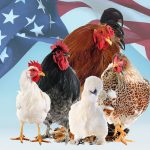Chicken Breeding and Genetics
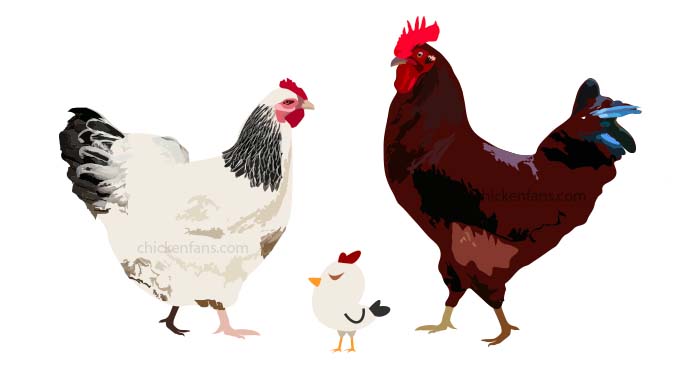
With selective breeding, it’s possible to create a chicken that has all the specific characteristics you are looking for. But it’s not just picking genes from a menu. It can get pretty complex. However, the basics are easy and fun to learn.
Let’s look at the basics of breeding and genetics:
- the chicken genome
- passing genes
- sex genes
- sex link cross
- feather colors and patterns
- egg color
- egg and chicken size
- breeding strategies
- summary
The Chicken Genome
Like in humans, a lot of the characteristics of a chicken are stored in its DNA. The color of the eggs, type of comb, feather pattern, and eye color are all stored in a chicken’s genetic material.
Every body cell of a chicken contains very long strains of DNA that describe more than 20,000 genes. If you would unravel a single DNA string in a chicken cell, it’s about 2 feet (60cm) long. This DNA string is not kept as one long chain but stored in multiple parts, called chromosomes. Humans have 23 pairs of chromosomes, and chickens have 39.
Chromosomes always come in pairs. One chromosome comes from the mother and the other one from the father.
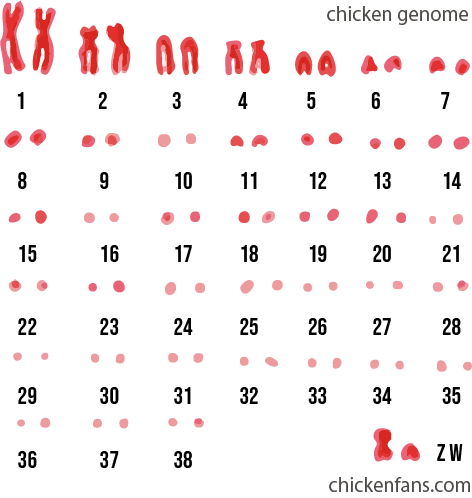
These chromosomes are chains of genes. The genes define what chickens look like. There are genes for eye color, egg color, feather patterns, etc. Sometimes it’s a combination of genes that prescribe a particular feature in a chicken. Chicken breeds have different combinations of these genes. The chromosome linkage map shows the location of all the genes on the different chromosomes.
Every chromosome comes in two copies, so everything is defined twice. There is twice the color of the eyes, twice the type of comb, etc. One copy comes from the mother, and one from the father, so they are not identical copies of each other.
One chromosome might contain a gene that says the feathers should be gold, while the other chromosome of the pair might say the feathers should be silver. That raises the question, which color will the feathers be? Gold or silver?
Passing Genes
In genetics, dominant genes always win. Let’s take the chicken’s comb as an example. In chickens, there is a single comb gene (r), and a rose comb gene (R).
As said, chickens always have two chromosomes, one from each parent. So they also have the comb gene twice. If you would mate a hen with a pure single comb (rr) and a rooster with a pure rose comb (RR), the chick will have an r from its mother and an R from its father.
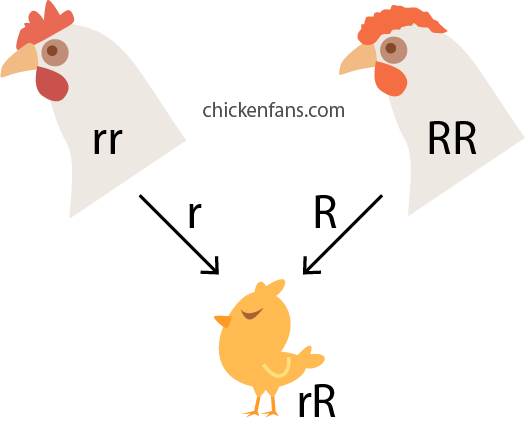
The resulting chick will have rR in its DNA. This means it will develop a rose comb (R) since the rose comb gene is dominant.
In this case, Rr is the only possible result. If one of the parents had Rr, it would be more of a lottery, and we would never know in advance what genes the chick would get until we see it growing.
In general, a chicken can have multiple combinations:
- rr: two times, the single comb gene
- rR: single comb gene from the mother, rose comb from the father
- Rr: rose comb from the mother, single comb from the father
- RR: two times, the rose comb gene
The rose comb gene (R) is dominant. So, all chicks with at least one rose comb gene will develop a rose comb. In our example, these are the chicks with rR, Rr, and RR. Only the chicks that inherit the single-comb gene (r) twice from their parents will develop a single comb.
Multiple Comb Types
In chickens, the comb type is actually a combination of multiple genes. The most prominent genes are:
- Pea Comb gene (P): a dominant gene that will generate a Pea comb if it’s present. When written with a capital P, it means the gene is present. An absence of the gene is written as p.
- Rose Comb gene (R): a dominant gene that will generate a Rose comb if it’s present. When written with a capital R, it means the gene is present. An absence of the gene is written as r.
If none of the dominant genes is present, the default fall-back is a single comb. So, if a chick inherits p from its father and p from its mother, the chick (p,p) will have a single comb. However, if the chick inherits one or two P’s from its parents, it will develop a Pea Comb. The same holds true for Rose Combs, as we’ve discussed above.
When both Pea Comb and Rose Comb genes are present, the resulting comb is a Walnut Comb.
Putting it all together, this gives us the following combinations:
- Single Comb: only when there is no Pea Comb gene = (p,p) and no Rose Comb gene (r,r)
- Pea Comb: when there is at least one single Pea Comb gene (P, -) but there is no Rose Comb gene (r,r)
- Rose Comb: when there is at least one single Rose Comb gene (R, -) but there is no Pea Comb gene (p, p)
- Walnut Comb: whenever there is at least one single Pea Comb gene (P, -) and at least one single Rose Comb gene (R,-)
This can become even more complex when other comb-modifiers come into the mix. For example:
- hens with the Breda combless gene (bd) are completely combless
- a smooth modifying gene will turn a Walnut Comb into a Cushion Comb.
The passing of genes becomes really interesting when we look at the sex chromosomes.
Sex Genes
Just like in humans, the sex of a chicken is defined in its DNA.
Humans have 22 regular chromosome pairs and one pair of sex chromosomes. These sex chromosomes are the X and Y chromosomes that determine a person’s sex. If you have two X-chromosomes, you are genetically female. If you have an X and Y chromosome, you are genetically male.
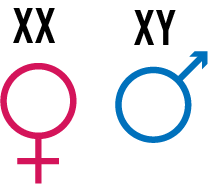
Chickens don’t have X and Y chromosomes. They have Z and W chromosomes. And in contrast to humans, it’s the hens that carry both the Z and W chromosomes. The roosters have two Z-chromosomes. So in chickens, the male has two of the same chromosomes.
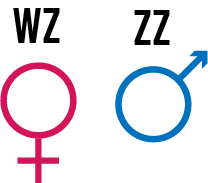
When roosters and hens mate, they pass their chromosomes to the chicks. Since a rooster only has Z-chromosomes, it will always pass a Z-chromosome. On the contrary, a hen can pass its Z-chromosome or its W-chromosome.
If a hen passes its Z chromosome, the chick will be a rooster. If the hen passes its W-chromosome, the chick will be female.
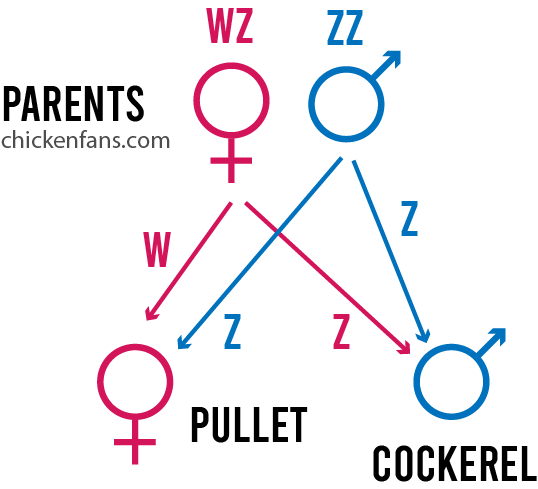
Sex Linked Genes
It’s not the sole purpose of the W and Z chromosomes to determine the sex of a chicken. The sex chromosomes also carry other genes that express specific characteristics. Genes that are located on the sex chromosomes are called sex-link genes.
These sex-link genes express external characteristics that are ideal for creating sex-link crosses. Sex-link crosses are interesting since you can quickly recognize the sex of a newly hatched chicken just by looking at their feather colors and patterns.
Let’s see how that works.
Sex Link Cross
When hatching chickens, one of the most common questions is whether a chick is a boy or a girl. Most people don’t want a rooster or are not even allowed to keep roosters in their neighborhood. And it’s challenging to figure out if a chick is male. Sexing chicks is tough if all the chicks look the same.
One way of solving this problem is planning the mating of the chick’s parents and creating sex-link crosses. For a sex link cross, it’s easy to see whether you are dealing with pullets or cockerels since they look different when they get out of the egg.
To create sex-link crosses, we use genes located on the sex chromosomes Z, and W. One of such sex-linked genes is the Silver/White color of a chicken.
Let’s look at an example.
Sex Link Cross: Light Sussex and Rhode Island Red
Let’s say we have two parents mating:
- a white Sussex hen: the hen has a W and Z chromosome
- a pure breed Rhode Island Red rooster: the rooster has two Z chromosomes
The Sussex is white because of a dominant Silver gene. The Silver gene wipes out all colors of a chicken and makes it light or white. The chicken gets a lighter color whenever the Silver gene is present, as the gene is so dominant.
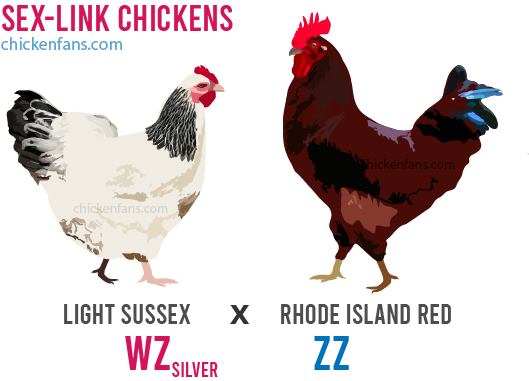
The Silver gene in our example is located on the Z-chromosome of the Sussex hen. The Rhode Island Red doesn’t carry the Silver gene. It’s a pure breed, and the Rhode Island Red is certainly not white.
Chicks of the Light Sussex and Rhode Island Red
The chicks that result from mating with these parents always get one Z-chromosome from their father, the Rhode Island Red.
However, the lottery will decide which gene they get from the white mother Sussex:
- the W-gene, which will give the chicks a W and Z chromosome, and the chicks are girls
- the Z-gene, which will give the chicks two Z-chromosomes, and the chick is a rooster
Now, remember that the Z-gene of the mother hen has a Silver gene. So whenever that Z-gene is passed, the chick will look pale.
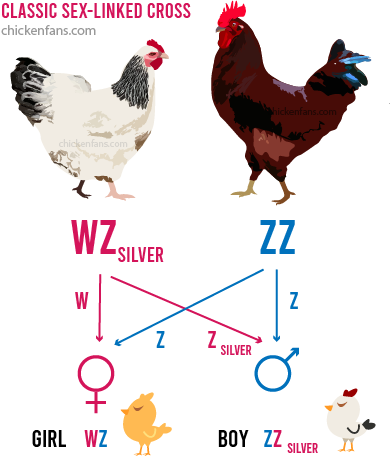
As a result, all the female chicks (WZ) will have a pigmented down color, whereas all the boys (ZZ) will look pale. The down color and pattern of the boys and girls look completely different whenever they get out of the egg.
Is the Sex Linked Cross a Breed?
The Sex Link Cross is not a Breed. Only the first generation is a sex-linked cross. Mating a pure breed Rhode Island Red and a silver Sussex will generate brown hens and silver cockerels. For all generations coming after this, the characteristic difference does not hold.
Other Sex Linked Crosses and ISA Brown
Our example of the white hen and red rooster is not the only way of creating a sex-linked cross. However, it’s a very popular one and it’s the classic sex-linked cross.
It’s also how they make commercial lines like Red Shavers and ISA Brown Chickens. An ISA Brown Chicken is not exactly a pure breed, it’s a hybrid or crossbreed. If you buy ISA Brown chicks in a hatchery, you buy the chicks of a sex-linked cross.
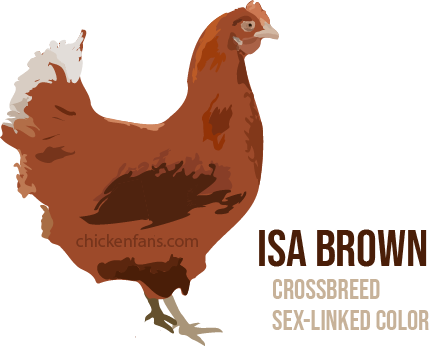
If you try to breed with these chicks, they won’t breed true. On the contrary, if you had pure-bred parents, you could breed your own ISA Browns. However, the exact genetic codes of the ISA Brown are a closely guarded secret.
Feather Colors and Patterns
There is a huge variety of characteristics that are interesting for chicken keepers to start selective breeding. In the poultry industry, the focus lies primarily on eggs for the supermarket. But backyard chicken keepers like to play with the looks of a chicken, and there are a lot of possibilities with shapes and colors. In poultry shows worldwide, you can see plenty of examples.
Let’s have a quick look at chickens’ feathers and patterns.
Chicken Plumage Color
Just like humans, chickens have two kinds of pigment:
- eumelanin (=melanin): the black/dark brown pigments of the feathers; in humans, this is what makes our skin and hair darker
- pheomelanin: reddish pigment, the ground color of a chicken; in humans, this is the pigment that makes our lips red
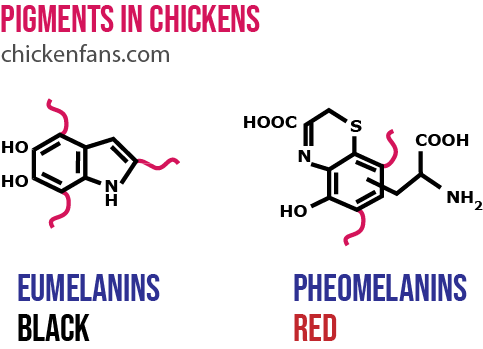
Chickens that look white don’t have any pigment in their feathers, which is called silver (S). The ground color of a wild-type chicken is brown, which is called gold (s+). Depending on the breed and genetic coding, this golden ground color can be altered into silver, yellow, cream, or red.
One example is the gold/red gene called Autosomal Red (Ap) that boosts the red in the mahogany-colored Rhode Island Red. To create silver breeds, this red sometimes needs to be suppressed to get the red pigments off the shoulders of a male.
On top of the ground color, there are black patterns based on eumelanin. Depending on the genes, chickens can turn completely black, have black areas, have feather patterns in black, or have any diluted form of black (like blue) in their plumage.
The Black E-locus Chicken Gene
One of the most important genes defining the eumelanin distribution in a chicken’s plumage is the E-gene. It can have multiple values that all result in different color patterns. On top of that, the actual outcome is influenced by many other genes.
The most common values are:
- Extended Black (E): hens with E will be largely black. Roosters with the dominant E will look like pigmented junglefowl with a black wing triangle, sometimes called a crow wing. Chicks have a black down, sometimes with cream or grey spots.
- Birchen (Er): largely the same as E, but with deeper black colors. Although predominantly black, there can be some silver or gold spots in the hackles and other parts of the plumage.
- Partridge, Brown (eb): roosters like wildtype junglefowl with heavier hackles and saddle striping, and the hens look like wildtype but have stippled brown breasts. Chick down is dark mink brown with lighter stripes and brown heads.
- Wildtype Duckwing (e+): the standard wildtype. Roosters are black-breasted red and hens have a salmon breast. Duckwing refers to the exterior triangular secondary feathers on the tip of the wing, well-known for regular male ducks. Apart from black-breasted red, there are also Silver Duckwing and Golden Duckwing variations. Silver Duckwing is a Duckwing that has the Silver gene. People use Partridge and Duckwing interchangeably, but in essence, they are different patterns. The down on the chicks makes them look like chipmunks.
- Wheaten (Ewh): the hens are wheaten-colored and have little to no black pigments on their neck or back. Their tail can also lose some pigment. The roosters look like wildtype but lack some segment in the hackles and saddle feathers. Chicks have a light down color, sometimes with striping, depending on the genetic combination (e.g. with Columbian).
That’s already a lot of possibilities, but it’s not even the complete list of all possible E-types. It becomes much more complex with other melanizer-genes in the mix. Melanizers can change the outcome of the E-gene and mask a lot of traits.
There is still a lot of research to figure out all the genes and their corresponding outcomes. Scientists use DNA-sequencing techniques on different breeds to locate the E-locus genes and their effects.
While the E-locus defines the base and distribution of the pigments, there are also restrictor genes that generate patterns.
Restrictor Genes
Some genes do not dilute colors but create patterns. These patterns can show up on the plumage as a whole or on each separate feather.
Examples of restrictor genes that generate patterns are:
- Columbian (Co)
- Mottled (mo)
- Barring (B)
Columbian
The Columbian gene creates a pattern that affects the chicken as a whole. The black pigment is restricted and the only places that show black are the tail and hackles. This can be seen, for example, in a light Sussex.
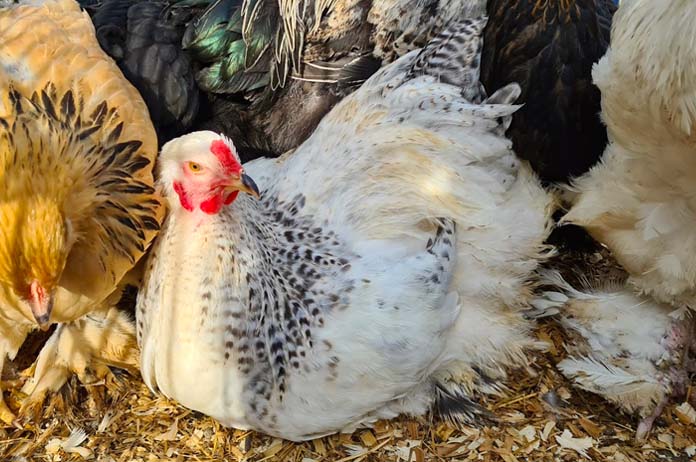
Mottled
The mottled gene affects the individual feathers. It restricts the black pigment on the tip of each feather, so each feather has a white end. This creates a mottled plumage. Mottling is a recessive gene, so it only happens if the chicken has two copies of the mottling gene in its chromosome pairs.
Mottling can express in many forms. Chickens with a single gene can sometimes show some mottling in juvenile plumage, but it will fade away as they age. Young birds can look pied, hysterically mottled, but turn white when they get older. Mottling is also linked to zonal mottling, a pattern that can be seen in Exchequer Leghorns.
Mottling can co-occur with other patterns to create stunning results. One example is the Tollbunt Polish which has a gold-laced pattern with mottling (also called jazz). Another example is the Mille Fleur pattern that can be seen on the Belgian D’Uccle, which is gold-spangled mottled. The different outcome between laced and spangled here is due to the Columbian (Co) and Dark-Brown (Db) genes.
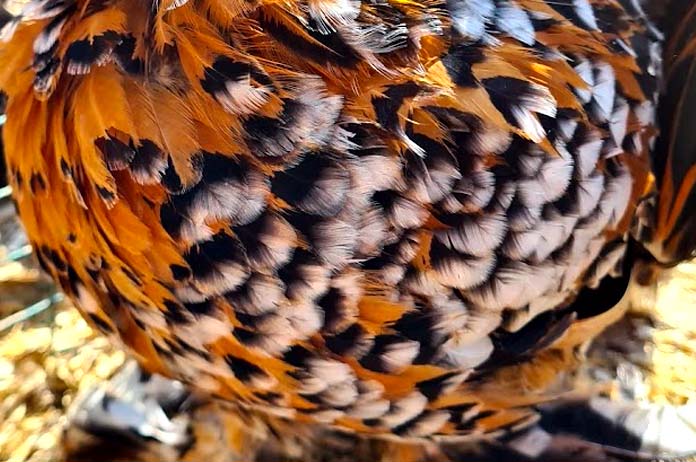
Since the Tollbunt pattern is so exclusive, people started copying it to other breeds. For example, some breeders in the US created Tollbunt Orpingtons starting their project with a gold laced rooster and Mille-Fleur colored Orpingtons.
Barring
The Barring gene affects the feather and causes stripes across the feather. The gene turns the pigmentation depositing on and off while the feather is growing, thereby creating the striped pattern.
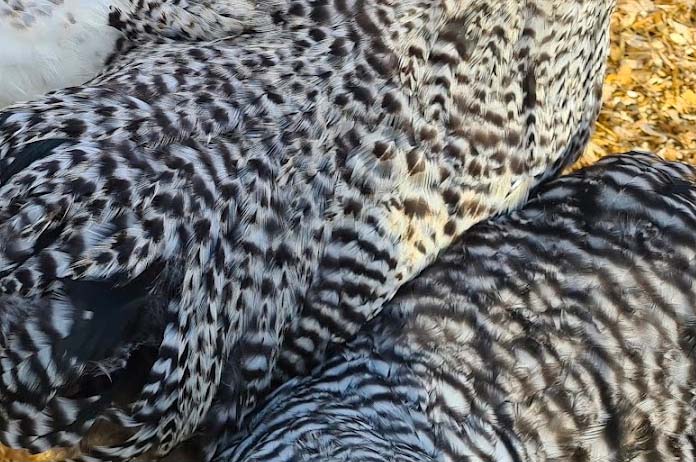
The most well-known breed carrying the barring gene is the Barred Plymouth Rock. The Plymouth Rock has slowly growing feathers, which creates a very sharp lining compared to other breeds that carry the gene. The barring gene is a sex gene, as it resides on the Z-chromosome of a chicken.
Lacing Patterns
The previous examples are rather straightforward patterns, where a single gene corresponds to a single pattern. There are other patterns, like lacing patterns, that are the result of a combination of genes.
Single Lacing
Single lacing occurs when each feather has a black rim around the ground color. This can be seen in the plumage pattern of the Silver Laced Wyandotte. The edge color can also be blue or white. This edging takes more than a single gene to achieve (Pg, Ml & Co). We discuss how these genes shift the feather pigments in the genetics section of the Silver Laced Wyandotte.
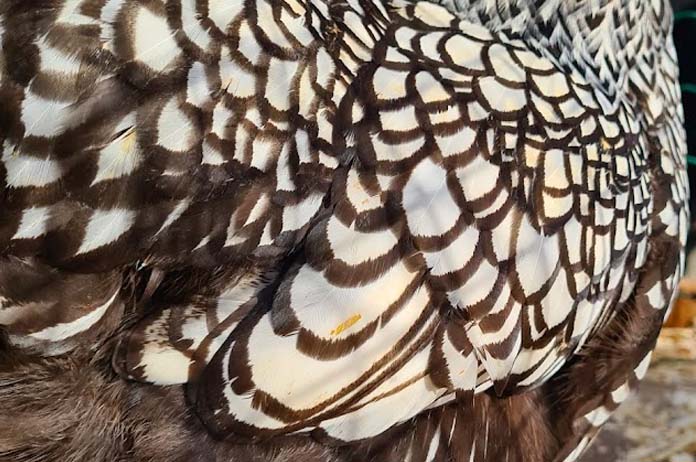
Double Lacing
Double lacing shows multiple lacing patterns on a single feather. It has a similar but slightly different genetic coding compared to single lacing.
The lacing patterns on the feathers combine the Columbian, mottled, melanotic gene (Ml), and pattern gene (Pg). The dominant pattern gene restricts the expression of eumelanin in concentric lines in some parts of the feather. By default, it leaves the outer rim in the ground color.
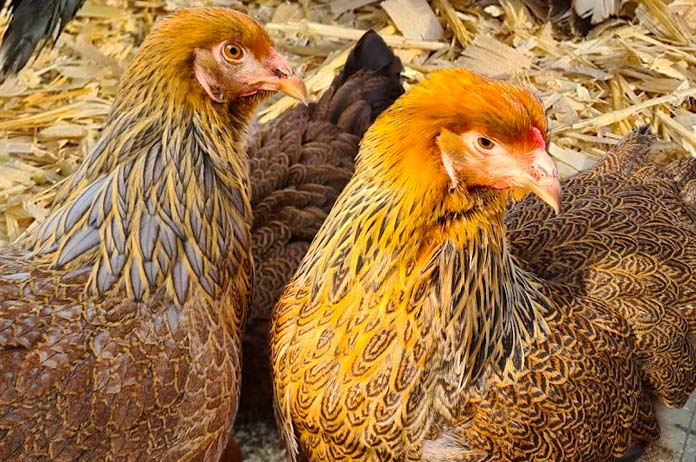
The melanotic gene moves the eumelanin lining. It shifts the black lines to the outer rim of the feathers, causing double lacing. This is the typical lacing pattern for Barnevelders.
When breeding for lacing patterns, it’s sometimes possible to use color-coding. That way, you can immediately recognize the gender of your chicks.
Pigment Diluters
Some genes act as a diluter for the feather pigments.
The most important diluter genes are:
- Dominant White (I): if this gene is present, it inhibits the black pigment eumelanin. It’s usually not waterproof and it’s leaky, allowing black to come through. However, it can produce white birds. The Leghorn is the most prominent example of a breed carrying the Dominant White gene. Most birds are white due to the Recessive White gene (c). Examples include white-colored Silkies, White Plymouth Rocks, and White Wyandottes, but the list is much longer. There is also Opal (cop), which is believed to be a mutation of recessive white.
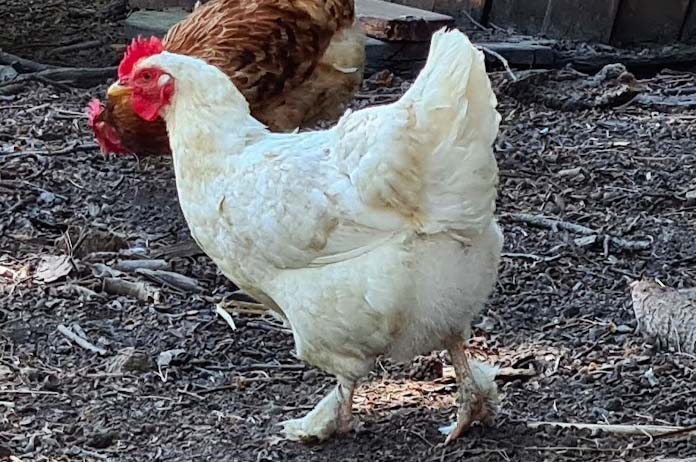
- Smoky (Is): on the same gene location of the Dominant White, there can also be the Smoky gene mutation. It dilutes the black pigments and creates a smoky blue color, which looks a lot like Splash blue.
- Dun (ID): the dun variant is also in the same location as Dominant White, and will result in an off-white to a somewhat khaki color. It gives a smooth color that can be almost Splash white. If the bird only carries a single Dun gene, the plumage is turned into chocolate brown.
- Chocolate (choc): a (rare) sex-linked gene that dilutes the Black pigment into chocolate. Males (ZZ) need two copies of the gene to turn into chocolate. Hens can not hide the gene. The chick down color is darker than the Dun versions. This gene can, for example, be used to create Chocolate Silkies.
- Blue (Bl): the blue gene dilutes the black pigments to Andalusian blue when only one copy of the gene is present.
- Splash (2xBl): when a chicken carries two Blue genes, the black becomes so diluted that it can turn into grey or true white, like the Dominant White gene
- Lavender (lav): this gene dilutes both the black and red pigments. It will render a black chicken grey and a red one creamy. The lavender gene does not prevent the pigments to be made by the chicken’s body but prevents it from getting into the feathers. The presence of the lavender gene is often associated with bad feather structure.
Since many of these genes can co-exist, there are many shades of white possible. For example, chickens with both Blue and Dun are called Platinum or Platinum Blue. Feathers of Platinum Blue roosters have been popular in fishing since the 1920s. They are used for fly tying; apparently, fish seem to like the Platinum Blue colors.
Eye Color
The eye color of a chicken is only partially controlled by genetics.
The color of the eye is regulated by melanophores, pigment cells that permit color change. They only use eumelanin, so the eye color is usually brown or black based. The amount (lack of) black pigment and the structural differences generate the appearance. When there is no pigment, the eyes turn blue. Just like in the feathers, the amount of black is determined by the E-locus genes and restrictor genes, like Barring genes.
Apart from what the genes dictate, the context also matters. Sick birds and vaccinations can give the birds some lighter eyes. Some people believe carotene also affects eye color (e.g. corn in maïs). When chickens are deposing their eggs, the carotene goes to the yolk and the eyes turn lighter. However, scientists could not find carotenoids, the yellow pigments, in chicken feathers.
Egg Color
The egg color is defined in the chicken’s DNA and is orchestrated by multiple genes.
The eggshell color gets its hue from mixing two pigments:
- Brown pigment, protoporphyrin, which is derived from hemoglobin
- Blue-green pigment, biliverdin, which is derived from bile
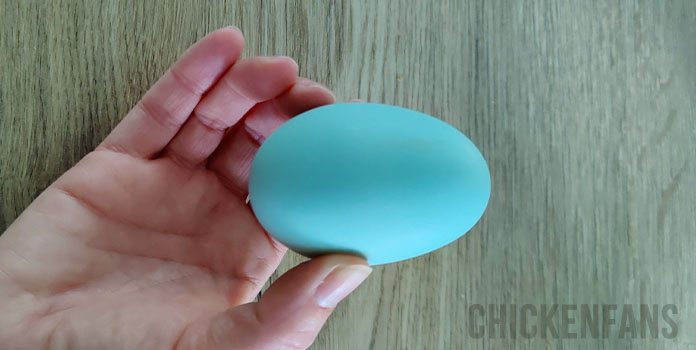
This can result in several egg colors:
- White eggs generally lack any pigments. The white color comes from the calcium carbonate in the eggshell.
- Brown eggs are the same as white eggs but are covered in a thin layer of brown, like paint. The pigments are deposited in the shell gland in the last step of eggshell formation. Several genes influence the brown color, but the exact process of secretion and coloring is not yet known.
- Blue eggs are special. Blue egg layers carry small parts of viral DNA on their first chromosome (o-locus) from an ancient junglefowl retrovirus. The virus is inactive, but the DNA unlocks the blue coloring of the eggs. The blue eggshells are completely blue on the inside and outside.
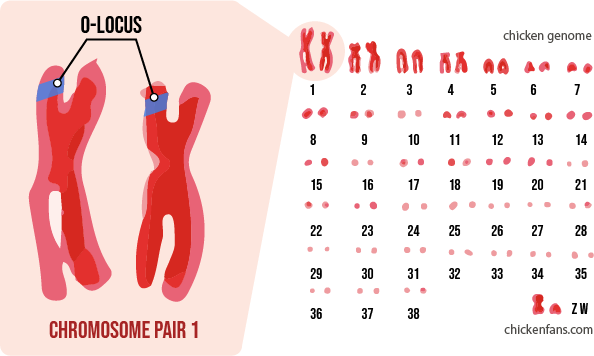
- Olive eggs are blue eggs with a brown coating. Whenever a chicken has both the genes for blue and brown eggs, it will lay blue eggs with brown surface pigmentation. This results in greenish, olive-colored eggs.
Fresh eggs have a bloom that protects the egg from bacteria infiltrations. The bloom of the egg can also contain some pigmentation and fluorescences of red to pink. This can give the egg a purple, pink, or plum-colored look.
If you are interested in eggshell color, we have an in-depth article on egg color genetics that goes into much more detail.
Egg and Chicken Size
Due to selective breeding in the poultry industry, chicks hatch half an ounce heavier than in 1950. Several, in-depth studies discovered genes that affect growth in chickens. These growth-factor genes are spread across multiple loci on chromosomes 1,2,3,4,7, 20, and 24. The most prominent genes that impact major growth are sex-linked and primarily found in roosters.
Dwarf Genes
Dwarf genes will delay the growth and result in an adult bird that’s much smaller. Some of these genes are gender-specific (dw-locus), while others are autosomal and occur in both hens and roosters:
- Autosomal Dwarfism (adw): Reduces the body size by 30% but keeps the same egg-laying rates. However, the hatchability of the eggs is poor. Described in 1793 by Cole on experiments with White Leghorns.
- Sex-Linked Recessive Dwarfism (dw): Chicks hatch normal, but adult hens will have around 30% bodyweight reduction, and roosters barely get half as big as their larger counterparts. As the gene sits on the Z-chromosome, the roosters can carry the dwarf gene twice, which results in even smaller birds. This mutation has been around since 1940, after it was researched by Hutt.
- Bantam Dwarfism (dwB): The actual gene that Bantams carry, the miniature chickens that are popular as pets.
- MacDonald Dwarfism (dwM): There is some evidence that there exists another mutation of the Bantam dwarf gene dwB, but the evidence is currently inconclusive
Bantams are popular because they take much less space in the chicken coop, need less food, and are very tolerant to heat. Some bantams come with stunning color patterns.
Breeding Bantam to Large Fowl and vice versa
To generate large fowl from a Bantam chicken, most breeders use a Bantam rooster and a large hen. They are convinced that a bigger egg brings bigger chicks, which leads to faster success. In the opposite direction, to create a Bantam line, they start with a Bantam hen group and cross the first-generation roosters back to them.
This raises the question, does the egg size defines the size of a chicken?
Egg Size
Researchers incubated chicken embryos cultured in Aigamo duck eggshells. The eggs are larger than chicken eggs and have a thick strong shell. Chicks that hatched from the bigger eggs developed higher body weight and later also produced higher egg weights.
Some people believe supportive selection with big surrogate eggs in combination with in-ovo nutrition might be a way to sidestep selective breeding and quickly create bigger chickens with larger eggs.
This discussion brings us to the field of epigenetics.
Epigenetics
Epigenetics is a rather recent field of study that investigates how the environment can cause changes in the way your genes work. External factors like nutrition, stress and diseases can alter the expression and activation of genes while the DNA sequence stays exactly the same. The old nurture-vs-nature discussion shifted towards nurture-shapes-nature.
In a ground-breaking experiment, researchers showed that changing the diet of mice generates offspring that inherited healthy aspects of their mother. These mice didn’t get fat and had excellent fur, although they had identical DNA. The differences were due to gene expression and epigenetics, inherited from the mother. Even the next generation had the same traits.
Let’s say you have two eggs that differ in size but contain the same DNA. You could argue that the size of the egg doesn’t matter since the size and growth of the chicken are encoded in its DNA.
However, the bigger egg has a bigger yolk and more nutrients. This perinatal nutrition gives the chick a head start. The theory is that epigenetics will lead to quick growth and a persistent effect of healthier, bigger chickens for the next generations to come. Selecting the bigger eggs when breeding would then result in genetic strains with larger chickens.
Breeding Strategies
When selective breeding is used to create a chicken with specific desired characteristics, a breeder has a couple of possible strategies:
- Outcrossing: outcrossing, also known as outbreeding, is breeding chickens that are unrelated to each other. These could be chickens of different breeds but can also be members of the same breed that have no relationship close up in the pedigree.
- Linebreeding: a breeding strategy with related chickens to keep the offspring close to a highly admired ancestor. Linebreeding involves mating sire to daughter, half-brother to half-sister, grandfather to granddaughter, etc.
- Inbreeding: refers to breeding chickens that are more closely related than the average chickens of a specific breed. Very close inbreeding includes breeding daughters back to their fathers for successive generations, sons to their mothers, or brothers to sisters.

Inbreeding is sometimes frowned upon, but it’s the quickest method of fixing desirable characteristics. Generally, inbreeding is safe for a couple of iterations. With linebreeding and inbreeding, the safe choice is to breed parents to offspring rather than use close inbreeding solely with siblings.
We go in-depth on these breeding strategies and mating patterns in our article on linebreeding, inbreeding, and outcrossing.
Summary
Our backyard chickens are beautiful creatures that come in many colors and patterns. The external characteristics of a chicken are defined in the genes on the chromosomes. These chromosomes and genes come in pairs, with a copy of the mother and a copy of the father.
Chickens have two sex chromosomes, W and Z. Hens have a WZ combination, while roosters have two Z-chromosomes. These chromosomes also carry other features, which allows us to create sex-linked crosses. The color-coding makes it easy to separate the boys and girls when chicks are hatching. Some commercial breeds like the ISA Brown are crossbreeds.
The color of a chicken consists of two pigments, eumelanin (black) and pheomelanin (red). Genes restrict, enhance, dilute or change the ground color of a chicken. On top of that, restrictor genes can create beautiful patterns on the chicken or its feathers.
Gene-controlled patterns include the Columbian pattern, mottling, barring, and lacing. Lacing is controlled by multiple genes and can result in various lacing patterns like single lacing or double lacing.




